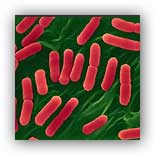News and Insights for
your best life. Online since 1998
- Home Health
- Breaking news
- In caso di...
- Per saperne di
più... - Medicina occidentale
- Medicine complementari
- Medicina cinese
e agopuntura - Omeopatia
- Fitoterapia

Wastewater from cities and hospitals releases some antibiotic-resistant bacteria into the environment, according to a new French study.
Wastewater treatment plants cut the number of bacteria overall, but the treatment process boosts the proportion of bacteria resistant to some antibiotics, a the research found.

E. coli
Drug resistance among many types of bacteria, including E. coli, is a growing problem. Previously unaffected bacteria can pick up resistance genes from other bacteria that carry them, and resistance can also spread through food crops irrigated with affected water.
The determinants of the spread of extended-spectrum ß-lactamase–producing Escherichia coli (ESBLEC) in the community remain unclear. To evaluate its dissemination in the environment, researchers analyzed the ESBLEC population throughout an urban wastewater network.
Samples were collected weekly, over a 10-week period, from 11 sites throughout the wastewater network of Besançon city (France). Total E. coli and ESBLEC loads were determined for each sample. As a control, researchers analyzed 51 clinical ESBLEC isolates collected at our hospital.
Researchers genotyped both environmental and clinical ESBLEC by pulsed-field gel electrophoresis and multilocus sequence typing and identified their blaESBL genes by sequencing.
The E. coli load was higher in urban wastewater than in hospital wastewater (7.5 × 105 vs 3.5 × 105 CFU/mL, respectively).
ESBLEC was recovered from almost all the environmental samples and accounted for 0.3% of total E. coli in the untreated water upstream from the wastewater treatment plant (WWTP).
The ESBLEC load was higher in hospital wastewater than in community wastewater (27 × 103 vs 0.8 × 103 CFU/mL, respectively). Treatment by the WWTP eliminated 98% and 94% of total E. coli and ESBLEC, respectively.
The genotyping revealed considerable diversity within both environmental and clinical ESBLEC and the overrepresentation of some clonal complexes. Most of the sequence types displayed by the clinical isolates were also found in the environment. CTX-M enzymes were the most common enzymes whatever the origin of the isolates.
The treatment at the WWTP led to the relative enrichment of ESBLEC. Researchers estimated that >600 billion of ESBLEC are released into the river Doubs daily and the sludge produced by the WWTP, used as fertilizer, contains 2.6 × 105 ESBLEC per gram.
For more information
Clinical Infectious Disease
Wastewater Treatment Plants Release Large Amounts of Extended-Spectrum β-Lactamase–Producing Escherichia coli Into the Environment
Université de Franche-Comté (UFC)
MDN
del Dott. Turetta
Quali sono i problemi o le disfunzioni che possono giovarsi di un intervento omeopatico d'urgenza e, di conseguenza, come dovrebbe essere un ideale armadietto medicinale omeopatico casalingo.- Home -
- Health -
- Depressione -
- Sexuality
- Environment -
- Food -
- Musica -
- Capirsi -
- Grafologia -
- Ridere
Copyright © 1998/2018 www.mybestlife.com tutti i diritti sono riservati eccetto quelli già di altri proprietari.
.In caso di
Pubblicità
Per saperne di più su
Pubblicità
Pubblicità
Pubblicità
Pubblicità


